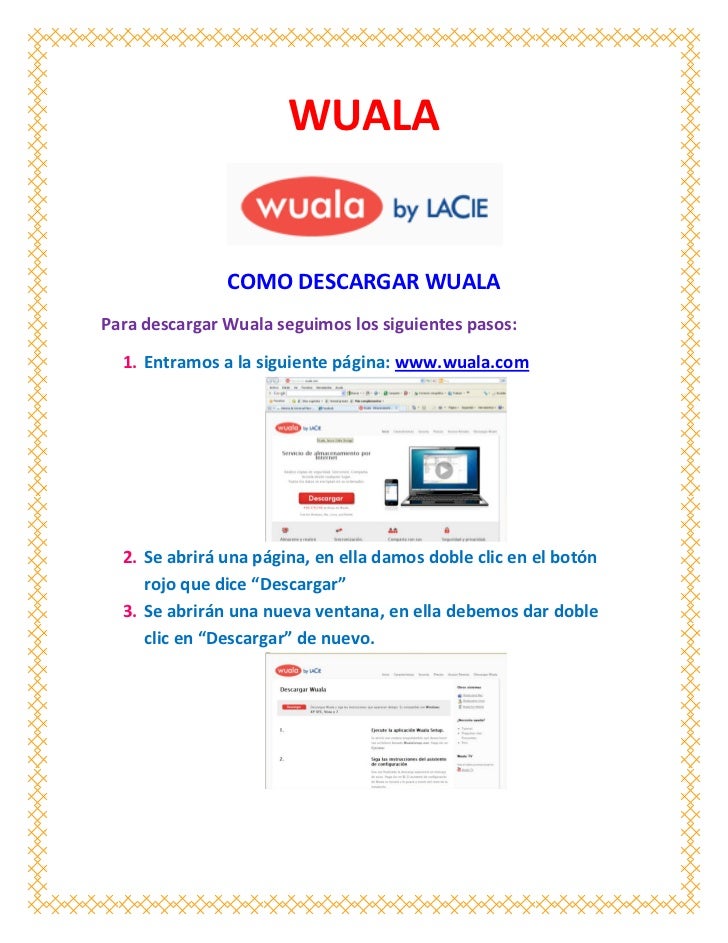

Set a VM as a Virtual USB Drive in Another VM That method may also be useful for other efforts to examine or work with the internals of a Linux (or, presumably, Windows) VM while that VM is not running.
Wuala slang software#
In the best approach discussed here, the interloper was simply a Linux (e.g., Lubuntu) VM that was customized to run software to facilitate the main purpose (e.g., by adding pigz and other packages to enhance my dd command). In my case, the target would be the one being imaged or cloned. This post describes two successful methods, and several unsuccessful methods, for using one Linux VM to run commands against another (target) Linux VM. For instance, that wouldn’t produce a bootable USB drive from the VM (i.e., a virtual-to-physical, or V2P, solution). But that wouldn’t help for some purposes. That would be easy enough externally: just copy the virtual machine files. The better approach would be to make an image or clone when those files were not in use. Likewise, it was difficult if not impossible to make certain changes (e.g., resizing partitions) while the VM was running. The image or clone might be unable to make a good copy of files while they were in use.

It was hard to make a good image or clone of a running Linux virtual machine (VM) because, unlike Windows, Linux did not have a Volume Shadow Copy capability. I didn’t try recreating the Lubuntu VM from scratch, but at least it was able to go online now.
Wuala slang windows 7#
The problem was not limited to the Lubuntu VM I had the same problem with Ubuntu and Windows 7 VMs in VMware Player.Ī reboot of the host system did fix all that.

Firefox in VMware was still unable to contact websites. Unfortunately, it still did not fix the Internet connection issue. That process gave me an updated Lubuntu VM in VMware Player. There were a few modifications (e.g., the VM would be named Lubuntu, not Ubuntu the size could be a mere 14GB, if desired, to fit onto an old 16GB USB drive) but generally the steps were the same. With that done, I shut down VirtualBox and used the steps described in another post to construct a VMware VM around its VMDK file.
Wuala slang update#
When it was done, I ran a few commands (somewhat redundant, but worth keeping together, and generally consistent with what appeared to be the best guidance) to update it as needed: sudo apt update On reboot, it said there were upgrades available. When the Lubuntu VM finished installing in VirtualBox, I rebooted the VM as it seemed to desire. Whatever the original issue was, it seemed to be entirely within VMware. The installation finished without any problems. In that process, I chose to create a VMDK rather than the default VDI file. There wasn’t an obvious solution.Īs a partial, temporary workaround, I shut down VMware and created the VM in VirtualBox instead. I ran searches to try to figure out the problem. At one point, the effort took over the host (Windows 10) system’s display - blacking it out and then resizing it to a much coarser resolution. It seemed the problem might be larger than just the Internet connection. I tried changing the VM’s network settings I tried proceeding through the installation anyway and I also tried installing Lubuntu 21.10 instead. But since I had some other processes running and did not want to interrupt them, I tried some other approaches. The real solution, for me, was simply to reboot the host system.

Apparently it was the specific reason why the VM did not satisfy installation requirements. That last line was highlighted in yellow. The system is not connected to the Internet. Installation can continue, but some features might be disabled. This computer does not satisfy some of the recommended requirements for installing Lubuntu 20.04 LTS. It said, “Welcome to the Lubuntu installer.” Then, a moment later, it said this: Its desktop offered an icon, “Install Lubuntu 20.04 LTS.” I double-clicked on that. I was installing Lubuntu in a virtual machine (VM) in VMware Workstation Player.


 0 kommentar(er)
0 kommentar(er)
